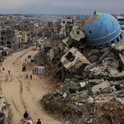Scroll to the bottom for Prospect Editor Bronwen Maddox's take on the "one-state" debate
Gush Etzion Junction is a big unkempt roundabout where two roads and several separate universes meet. To the north, the highway runs along the mountain ridge of the West Bank to Jerusalem. To the south, following an ancient route, it continues to Hebron and beyond. The east and west spokes lead to Israeli settlements and Palestinian villages. A new road sign on the eastern carriageway points to a nature reserve named after three Israeli teenagers who were kidnapped and murdered by Palestinian terrorists while hitchhiking in June 2014.
When I went to the junction on a wintry afternoon, some high school girls and a woman in a sweater-dress and beret were waiting to hitchhike north. Stickers on the nearby bus shelter warned hitchhikers to stand behind the concrete posts on the pavement. The posts are there to protect people from drivers who swerve onto the pavement to run them over—a common type of attack against Israelis by lone Palestinians in recent months.
There’s a petrol station and a supermarket on the west side of the junction. Security cameras are hung in groups from the lamp-posts outside, like the fruit of strange metallic date palms. At each of the roundabout’s four exits, I saw a pair of soldiers standing behind metre-high concrete cubes. They held assault rifles in their hands with the long magazines in, ready to respond to the next attack. On one of the cubes, someone had stencilled an advert in Arabic using spray paint: “DJ Re-Mash Music,” with a phone number. The worlds of everyday commerce and political violence touch and overlap here, as do the worlds of Israelis and Palestinians.
Between mid-September, when the latest wave of violence began, and mid-December, there were 109 attacks by Palestinians against Israelis in the West Bank and inside Israel. All, except for one, were carried out by individuals, or occasionally by pairs, acting on their own without the direction of the Palestinian militant organisations. Knives and cars were the usual weapons. The death toll included 19 Israelis and an American student—and at least 75 Palestinians were killed while attempting or carrying out attacks. Israeli human rights groups assert that soldiers and police have sometimes shot to kill even when the assailant was no longer a threat.
Eight of those attacks took place at Gush Etzion Junction. While I stood photographing hitchhikers, it occurred to me that I wasn’t protected by the concrete posts, and that my children wouldn’t be happy with me if I got run over for a camera angle.
There is a fruitless debate about whether what is happening constitutes a new Intifada—the word literally means “shaking off”, but has become the term for a Palestinian uprising. It is certainly very different from the First Intifada in the late 1980s to early 1990s, which involved mass confrontations with Israeli troops and widespread civil disobedience; or the Second in the early 2000s, in which competing Palestinian organisations carried out suicide bombings in Israeli cities. So far, there is no sign of an organised leadership. Assailants who were captured alive have told interrogators that they decided to act as little as half an hour in advance. The Palestinian Authority (PA), the autonomous government in large parts of the West Bank, continues to co-operate with Israeli security services to prevent terror attacks—though the lack of terror cells to penetrate and the use of everyday objects as weapons has made the job more difficult for both Israeli and Palestinian intelligence agencies. At the time of writing this, it looks less like a revolution than an epidemic of violent despair.
The backdrop for that despair includes the obvious lack of interest of Benjamin Netanyahu, the Israeli Prime Minister, in negotiating a two-state agreement and the failure of Mahmoud Abbas, the Palestinian President, to bring any progress toward independence. The current violence, say some analysts, is the latest proof that the two-state concept is dead. “The only thing left is to face the reality in which Israelis and Palestinians are hopelessly entangled,” wrote Asher Schechter, an Israeli commentator, in the newspaper Haaretz. “The binational state that the architects of the two-state solution warned us about looks very much like the one transpiring before our very eyes.” In this picture, Jews and Palestinians have become two ethnic communities locked in a single political entity and engaged in low-level conflict—with one community holding power and the other chafing against it.
Read more on Israel and Palestine:
Jimmy Carter: there is zero chance for the two-state solution
Silvan Shalom: “the fact that there is no peace process is not our fault”
As someone who has covered the Palestinian-Israeli conflict for nearly 30 years, I believe that depiction is mistaken. The political regime inside Israel remains fundamentally different from that in the occupied territories. Aside from in Jerusalem, Israeli society and West Bank Palestinian society have grown apart—not closer together. The divide between Israel and Gaza is even deeper. Though comparisons to other nations’ history are rarely useful, it is more correct to see the West Bank as Israel’s Algeria than to claim that Israel has become South Africa.
It is true that the situation today is oppressive for Palestinians and self-destructive for Israel. And it is true that the recent bloodletting is a consequence of the lack of diplomatic progress. But the West Bank and Gaza have not merged with Israel, and a two-state arrangement is still the most realistic alternative to the current situation. Or to quote a character in the Hollywood film Argo, “This is the best bad idea we have, sir.”
W hat is happening in this latest round of violence? A little more than 10 per cent of the attacks occurred inside Israel, not counting Jerusalem. Just over a quarter were within the municipal borders of Jerusalem—most in Israeli-annexed East Jerusalem or close to the so-called “seam line,” the pre-1967 border. The rest were in the West Bank—particularly in Hebron (the only place where Israeli settlers live inside a Palestinian city), at Gush Etzion Junction and at Israeli army checkpoints.
Overwhelmingly, then, the arena of bloodletting has been occupied territory, with settlers and Israeli troops as the target. Only three of the attackers have been Palestinian citizens of Israel; the rest were from East Jerusalem or the West Bank. That may change, but this is what has happened so far. And so far, the violence expresses the anger of people living under occupation against the occupiers, of the colonised against a colonial regime.
Proponents of the single state would argue that the reason for the geographical distribution of attacks is that most West Bank Palestinians cannot get into Israel. But this only emphasises the point: despite the growth of the settlements, Israel and the occupied territories have slowly moved apart. The days when residents of the West Bank and Gaza could travel freely inside Israel, and when Israelis could go dancing in Bethlehem on Friday night because nightspots in Jerusalem were closed for the Sabbath, ended with the First Intifada. After the Oslo Accords, signed in 1993 and 1995, the PA took over day-to-day government services in the West Bank and Gaza, reducing most Palestinians’ contact with Israeli civilian officials—though in the long term, not with soldiers. Meanwhile, Israel built roads to settlements that looped around PA-controlled areas and settlers no longer drove through Bethlehem or Ramallah on a daily basis.
"Creating a single state would mean the issue of borders would evaporate. But all other issues at dispute would remain"
At the beginning of the Second Intifada, the Israeli army—under the laws of occupation, the official sovereign in the West Bank and Gaza—barred Israelis from entering PA-administered cities, fearing they might be kidnapped or killed. At the same time, Israel sharply cut the number of work permits available to residents of occupied territory—from 150,000 on the eve of the uprising to 40,000 two months later. Wages earned in Israel had made up “close to 20 per cent of the national income” of the occupied territories, says Dr Sami Miaari, a professor at Tel Aviv University’s Department of Labor Studies. The Palestinian “private sector completely collapsed,” threatening the stability of the PA. Only in 2009 did the number of Palestinian workers in Israel begin to rise again. Miaari estimates that the figure today is half of what it was before 2000—and a much smaller proportion of a growing population. At most, he believes only a few hundred of them come from the Gaza Strip. The Gaza enclave has been virtually cut off since Hamas seized control of it in 2007 and Israel imposed a gradually tightening blockade.
In response to the economic crisis of 2000, says Miaari, the PA tried to employ workers from the private sector using funds from donor countries. Put differently, the Palestinian economy is less entangled with Israel’s, but no closer to being independent. There are two economies, conjoined in a colonial relationship, with Israel controlling borders, imports and exports. The donor countries have inadvertently become the enablers of occupation. But if they cut off funds, the first people to suffer would be Palestinians. To build a functioning economy, as Palestinian businessmen have told me, the essential ingredient is political independence for the West Bank and Gaza.
Jerusalem is the one place where the Palestinian-Israel division has blurred, but up to a point. Immediately after the Six-Day War in June 1967, Israel unilaterally annexed East Jerusalem, joining it to the west city and creating a single municipality. The neighbourhoods Israel has built in the annexed areas are home to 200,000 people, over a third of all the Israelis living in occupied territory.
Israeli law applies in East Jerusalem, in contrast to the rest of the West Bank. East Jerusalemites gained the status of Israeli residents. Officially, they can ask for citizenship, but a combination of Israeli bureaucratic hurdles and Palestinian social pressure not to legitimise the annexation makes it rare.
Resident status, though, provides the right to free movement and employment inside Israel. The most reliable estimate is that 35,000 East Jerusalemites work in the west side of the city, according to attorney Daniel Seidemann, a prominent expert on East Jerusalem. If they vanished, he says, “the economy of West Jerusalem would collapse.” The east city’s Palestinians have grown even more tied to the west city since the Second Intifada, when Israel built a high concrete wall between Jerusalem and the West Bank and set up permanent checkpoints at the entrances to the city. More East Jerusalemites study at Israeli universities and colleges; a growing number of Palestinian professionals work on the Israeli side. More than anywhere else, Jerusalem is where Jews and Palestinians meet daily. More than anywhere else, it is where Israelis cannot avoid the fact that they live in the Middle East rather than Europe.
And yet, East Jerusalem is still the first circle of the occupation. Jewish residents of Jerusalem rarely visit Arab areas or know their way around them. After years of underfunding, Arab neighbourhoods look more like towns in the Third World than the First World. East Jerusalem’s hope for a better future depends on it being the central city in a Palestinian state—as befits its size, location and history—but with an open door to Israel. Only then could it become a bridge rather than a dead end.
Even with the anomaly of Jerusalem, the space between the Mediterranean and the river Jordan is not one state. It consists of Israel—a flawed democracy—and the West Bank, more or less a colony, where settlers from the home country live apart from the local population, under separate laws, pampered by government support that drains Israel’s resources. Gaza is a world apart.
This is not a second South Africa. The desire to describe it as such reflects our habit of fitting something complicated and unfamiliar into a category that we already know and then fooling ourselves that we understand it. The situation in Israel and the occupied territories is not apartheid. It is pernicious, but in its own way.
B esides being used as a bad description of the present, the one-state concept is used in other ways: as a warning of what Israel will become if a two-state agreement isn’t reached soon, or as the only practical way out of the mess since the two-state option is supposedly dead.
I have used the one-state warning myself, but I’m now less convinced that this is where we are inevitably heading. The more likely scenario is that the current situation goes on, which means continued deterioration: increasingly frequent and more violent waves of opposition, in which random civilians are often the victims; more settlers; more damage to democracy inside Israel as the political right works ever harder to silence criticism. This is sufficient reason for change, without the one-state bogeyman.
Among those who describe a single state as the solution, the standard argument is that settlements have grown so large that Israel can’t withdraw. “We have grown too late for that,” the late historian Tony Judt wrote in a 2003 essay, “Israel: The Alternative,” which became a manifesto for “a single, integrated, binational state of Jews and Arabs, Israelis and Palestinians.”
Ironically, this is the same claim about settlements used by some Israeli hardliners, for whom it means, “Give it up, world. We’ve won.” To bolster their case, they have a tendency to inflate the number of settlers and deflate the number of Palestinians. Naftali Bennett, head of the hard-right Jewish Home party, said in a 2013 Washington Post interview that there were 700,000 Israelis living in the West Bank, including East Jerusalem. At the time, the figure given by Bennett was a full 30 per cent higher than the actual number, as Bennett could have learned if he had bothered to check the Israeli government’s data.
Still, the most accurate number available for Israelis living beyond the pre-1967 border is 570,000, which seems daunting enough. It’s also much larger than the actual number who would need to be evacuated. The spurts of serious negotiations since the 1990s haven’t produced a final agreement, but they have developed the principle that one-to-one land swaps between Israel and the new Palestinian state would allow Israel to keep the Jewish neighbourhoods of East Jerusalem and other large settlements close to the pre-1967 border. Depending on the exact map, the number to be evacuated would probably be 150,000 or less. For comparison, Israel absorbed over 180,000 immigrants from the Soviet Union in 1990 alone. The discussion of how to evacuate settlers peacefully would be long, but one idea is to say they could stay put as citizens of Palestine. My guess is that the number who would accept that offer would be in the dozens.
F or some one-state advocates, though, the point is not practicality but principle: the ideal is a single polity with equal rights for all, rather than partition into two nation-states. Again, South Africa is their model, and again, the comparison fails. One reason that a single state was feasible there—as Assaf Sharon, assistant professor in the Philosophy Department at Tel Aviv University and co-chair of the left-wing think-tank Molad, recently wrote—is that the African National Congress (ANC) proposed a South Africa that “belongs to all who live in it, black and white,” to quote its 1955 Freedom Charter. The re-imagined nation included the white minority.
But there is no Palestinian faction or organisation that proposes a similar programme. “If you look at the history of the Palestinian national movement… it was almost always a struggle for national self-determination rather than a struggle for democracy,” says Mouin Rabbani, a senior fellow at the Institute for Palestine Studies. “If you go for democratic equality among Israelis and Palestinians, then clearly you can’t have the same level of national self-determination that the ANC ends up getting… If you gave Palestinians today a clear choice, I suspect that most would prefer to live independent of Israelis than in equality with them.”
On the Jewish side, likewise, the goal was and remains self-determination. Among Israeli Jews today, support for a one-state outcome is to be found among a small number of academics, far-left activists and expatriate intellectuals.
And if, for a moment, we consider what would happen if a single state were established today, accurate population figures become very important. According to Sergio DellaPergola, an Italian-born Israeli demographer at the Hebrew University of Jerusalem, Jews presently make up 48.1 per cent of the population between the river Jordan and the Mediterranean. Add in non-Jewish immigrants from the former Soviet Union who identify as part of Jewish society, and the number rises to 52.1 per cent. Besides a small number of African refugees and foreign workers, the rest are Palestinians.
Creating a single state, therefore, would force two national communities, each committed to self-determination, into one polity, with their electoral power virtually balanced. The issue of borders would evaporate. But all the other issues at dispute between them would remain—control of holy places, allocating resources, Israeli settlements built since 1967 in the West Bank, repatriation of Palestinian refugees, and more. This is a plan for escalating the conflict, not solving it.
In no way do I mean to suggest that getting to a two-state agreement would be easy. “It’s obvious,” says Rabbani, “that the more settlers there are, the more political will” is needed to remove them and reach an accord. Political will for resolving the conflict is in short supply—in Israel, but also in Abbas’s vicinity and internationally. Neither the United States nor Europe appear interested in using the political leverage they possess with both Israel and the Palestinians.
And yet, a two-state accord is still the least difficult path to independence for Palestinians, rehabilitated democracy for Israel and a future where the two sides can meet less grimly than they do at Gush Etzion Junction
Frustration and hate lead the "one-state" debate
Almost no one involved in the deadlock between Israel and the Palestinians talks about a “one-state solution.” A “one-state outcome” is the phrase that they might grudgingly invoke—not the preferred path and almost certainly not a “solution” but the destination towards which the region seems to be drifting in the absence of a deal.“One state” is shorthand for the prospect that there would be a single state from the Jordan river to the Mediterranean sea. That is different from the present, where the state of Israel has also occupied territory in the West Bank and East Jerusalem earmarked for a Palestinian state. It is different from the “two state” goal, the target of diplomacy for more than two decades: the notion of two separate states for Israelis and Palestinians, side by side.
Some, particularly on the European left (Tony Judt, the British historian, was one as Gershom Gorenberg points out), have reached for this as a high ideal: one state, with equal rights for all. But that has been a fringe view. The thrust of international diplomacy since the Oslo Accords of 1993 and 1995 has been to separate two peoples who have each wanted their own land, not to live with each other.
You hear the “one state” phrase raised again these days, though. You hear it from young Palestinians, who have watched the land that would make up a Palestinian state eaten up by Israeli settlements. This is apartheid, they say—we are ruled by Israel but denied civil rights—invoking the comparison with South Africa that is driving the boycott, divestment and sanctions (BDS) movement. Give us the vote in a single country, they say. You hear it sometimes too, in what may be exploration of future tactics by older Palestinians—a challenge that would be a way of calling Israel’s bluff. Mohammed Shtayyeh, a Palestinian politician and economist who has written widely about the erosion of the two-state solution, told Prospect in June that there might come a time when switching to a call for one state made sense, if the possibility of a viable Palestinian state finally seemed extinguished.
I find it hard to see that as, at this stage, more than a kind of deliberately hazy testing out of a possible future challenge to Israel, a way of calling its bluff. Bleak as the prospects for a two-state solution are, that is still where all international effort—and formal Israeli and Palestinian discussion—is still located, because the alternative seems so much worse. The thrust of diplomacy in all kinds of conflicts in recent decades has generally been to separate warring people, not forcibly combine them in a democratic structure (and the examples where that has been tried, such as Iraq, are not encouraging). It’s not obvious (to put it mildly) how it would satisfy Israel’s security concerns, or what happens to Hamas-controlled Gaza.
The “one-state” idea also runs entirely counter to the Palestinian quest for nationhood and self-determination—a country of their own, not rights within another—which has been the leadership’s focus for decades. And however unattractive the notion of a state defined by its religious character is to many (including to many secular Jews), the “one-state” model offends the powerful sense of many Israelis that the point of Israel is that it is a Jewish nation.
I’m with Gershom Gorenberg in finding the two-state solution still the least bad goal, and the alternative resembling a recipe for a war zone. But in the absence of progress—and at the moment, there is none—that will not be the last word. Bronwen Maddox is Editor of Prospect
Bronwen Maddox, Prospect Editor












